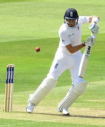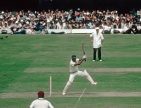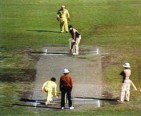When Holding Cooked Bob’s Goose
Gareth Bland |-274x433.jpg)
The third Test in the 1984 series between England and West Indies is perhaps best remembered for Malcolm Marshall’s literally one-handed devastation of England’s second innings. Having injured his left hand in the field during England’s first innings, he gallantly wafted Paul Allott for a boundary through the slip cordon, injured hand in plaster, during West Indies first knock of 302. Thereafter he wreaked havoc on David Gower’s men during their own second innings. Perhaps less well remembered,though, this encounter was also Bob Willis’ 90th and last Test match for England. The great England fast bowler, “Goose”, would not look back on the game with the same feeling of joy as Malcolm Marshall, however.
Having ceded the captaincy to David Gower at the conclusion of England’s winter tour of Pakistan, Willis, returning home early from the subcontinent injured, was back in the ranks as senior pro for the 1984 home summer. Come the third Test, and with England already 2-0 down in the series, the home team looked to reverse the trend at Headingley. With the first day played in an atmosphere described by Matthew Engel in Wisden Cricket Monthly as “a weird light reflecting off a dry, biscuit coloured outfield” England compiled 270, with Allan Lamb following his century in the previous match at Lord’s with an even hundred here. Beginning their own first innings early on the second afternoon, West Indies were soon in danger due to sustained pressure from Paul Allott, the Lancastrian’s nagging length pinning down Lloyd’s men. Five of the seven wickets to fall had been victims to Allott’s concerted strangulation of scoring opportunities as he ran in up the hill. From the other end, the fabled Kirkstall Lane End, a venerable old performer steamed in, raging against the dying of the light. It was at this juncture that a noble and occasionally glorious international career met its end. At 206-7 late on the second afternoon, Friday 13th July, 1984, Larry Gomes was joined in the middle by Michael Holding.
When Holding departed the scene on the third morning, West Indies had recovered sufficiently to take the lead. A score of 206-7 had moved on to 288-8. The manner of that partnership, however, did more than recapture the initiative. Holding’s 59 effectively ended Willis’ international career. In short, the Jamaican’s 59 came off 55 balls and including 5 sixes and 3 fours. Each of those sixes came off the bowling of Willis as he thundered in from the Kirkstall Lane End. The first came on the Friday afternoon where, from a good length delivery, Holding pulled the ball with a full-blooded swing high over mid-wicket. Immediately afterwards, the very next ball, the batsman somewhat fortuitously top edged a hoik over Paul Allott’s head at deep fine-leg. On the third morning in the opening over Willis’ loosener was greeted with a pull-cum-hoik over deep mid-wicket which sailed over the ropes. The fourth blow was the best of the lot. In stand-and-deliver fashion, Holding blasted Willis high over long-on with a clean swing. This was a shot worthy of Richards and Sobers and was soon followed up by the fifth six of Holding’s innings. This time, a well timed swish of the bat took the ball rocketing over mid-wicket in the same manner as the first and third blows for six.
As Holding’s beaming grin followed the completion of his half-century, a note of sympathy and concern crept into the voice of Jim Laker as he attempted to make sense of the carnage from the safety of the commentary position. This was time, the Yorkshireman argued, for David Gower to grant Bob Willis “a longish rest”. When Holding was finally dismissed, caught on the boundary by Allott at deep fine-leg as he attempted yet another blow over the boundary ropes, Willis was immediately comforted and cajoled by his old partner in crime, Botham. The drained expression on Willis’ face suggested he was in no mood to celebrate as he moved towards the fielder, Allott, to acknowledge the catch.
The latent shock in revisiting Holding’s innings from that July twenty-nine years ago is also a result of the juxtaposition of the physical characteristics of the two men themselves. One, Willis, physically awkward and gangling, straining every muscle and sinew to propel the ball to the batsman at the other end at top speed. The other, Holding, lissome and sinuous, elevating the act of fast bowling to a branch of performance art. With an ailing Willis at one end and an unhelmeted Holding – what an affront! – at the other, it seemed almost cruel that blow after blow should disappear into the crowd seemingly without effort. There is, of course, a certain stretching of the stereotypes here, but the shock of witnessing the passage of play at the time was compounded by these physical contrasts.
What exactly had happened? How could England’s premier strike bowler, in his 90th Test, have been subjected to such treatment by a number nine? This was not a shellacking meted out as a result of some personal vendetta, as was the case with Viv Richards and Willis four years earlier when the Warwickshire man’s fourteen overs went for 99 runs. Holding and Willis, after all, have sat happily alongside each other in commentary boxes ever since. There was no personal rancour, then, to add spice to the onslaught. A more likely cause, though, is the level of wear and tear that bowling genuinely quickly brings to the human frame. When that frame belongs to one RGD Willis, with a catalogue of injuries accumulated over fourteen years at the top level,then it was a miracle that he was even playing Test cricket at all.
From 1978 onwards it was felt that he was being patched up for one last stint at the front. In 1980/81 when he returned home prematurely from the Caribbean some commentators felt that that was surely the end of that. Perhaps the selectors themselves, prior to Headingley 1981, thought that his inclusion for that Leeds Test was a valedictory gesture, too. But no, on and on he went. Serendipitously he came by the England captaincy in 1982. In 1983 he was still capable of jarringly raw speed, at the age of 34. The youthful Martin Crowe was the rabbit in the car headlights at the Oval in that summer’s first Test as Willis first drew him forward and then plucked out his off-stump with sudden away drift at high velocity. In the Headingley Test of that same series, he looked like replicating his 1981 heroics as the Kiwis chased down a meagre hundred to win. Willis’ 5-35 had pinned them down to 83-5 at one stage.
Bob Willis could not go on, of course. Age and injuries had caught up with him. That he was still around at 35 was an achievement in itself. The circumstances of his last Test, though sad, were by no means an ignominious way to bow out. For even in the eye of the onslaught he still roared in, limbs pumping like pistons, as he summoned up one last effort. There is something ultimately uplifting in that. The absolute cutting edge of his speed had clearly gone, and, given that the awkward Headingley surface favoured a fuller-length a la Allott, it is perhaps not so surprising that his shortish deliveries should have fed Holding’s swirling Symonds Tusker blade in the way they did. Probably the saddest aspect, though, is that the whole episode should have taken place at Headingley, from his beloved Kirkstall Lane End, at all. Three years earlier, after all, he had performed such deeds from that same slope that he, born in Sunderland, would become as synonymous with it as FS Trueman himself.





Nice piece Gareth – I remember the game well, but had quite forgotten the particular contest between Willis and Holding
Comment by martin chandler | 12:00am BST 20 June 2013